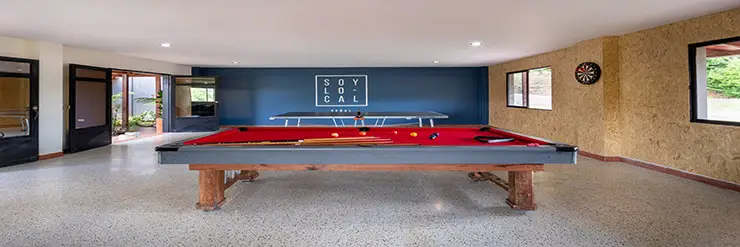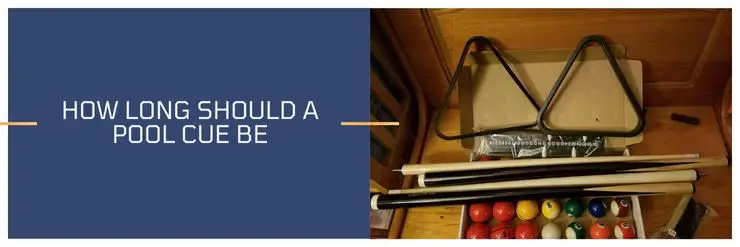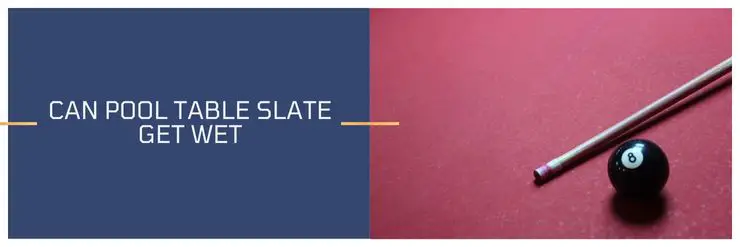Are you thinking about moving your pool table this weekend? Attempting to fix one of the legs underneath? What should you do? Is it OK to flip your pool table on its side when either moving it or trying to fix an issue? Read on to find out!
In short, can you turn a pool table on its side? The ability for your pool table to be laid on its side ultimately depends on the particular type of table you have. In the majority of cases, however, you should never turn your pool table on its side, especially a slate table.
OK, great…so if I have a heavy pool table, am I simply screwed? What should I do in that case? Also, what if my pool table feels light? You think there’s a slate underneath the felt – then what?
Glad you asked, let’s read on to find out more!
A Primer On Pool Table Weight
Firstly, a brief primer on what makes pool tables so heavy and why they should never be placed on their side: standard pool tables contain slate underneath the felt-playing surface, which can weigh up to 500 pounds alone. Thus, due to their excessive weight, pool tables are only meant to remain top-side up.
In any other position, the weight will be displaced and the risk of damage to your table will be substantial. However, if you have a lighter pool table – such as an MDF table – these potentially may be placed on their side, depending on the specific instructions within the owner’s manual. Ultimately, it is crucial to check your owner’s manual before doing anything with your pool table.
Types of Pool Tables
There are three general types of pool tables:
- Your standard slate pool table – must be disassembled or moved in one piece.
- Your coin-operated pool table (in bars/arcades) – must be disassembled or moved in one piece.
- Your MDF pool table – can be turned on its side (depending), or folded and transported.
If you are not sure which type of table you have then check out my guide on how to tell if a pool table is slate
What you will shortly discover, is that the first two types of pool tables must be either disassembled completely – a lengthy and cumbersome process – or moved entirely as one piece on a sizable dolly. Therefore, if you are looking to save time, it is best to hire a professional pool table operator in order to take care of this entire process for you. If you do indeed have a few days and truly wish to accomplish this yourself, then make sure you have adequate assistance, as the slate is quite heavy and you will need at least one other person to assist you.

If you are looking to move your heavy pool table then these dollies are perfect for moving a pool table (Amazon link)
If you are in possession of an MDF table, you have more flexibility in terms of relocation, as these tables are considerably lighter and, in some cases, have the ability to be folded. MDF tables harbor fiberboard as the centerpiece rather than the traditional slate – the primary reason for their vast weight differential.
If you have a standard, slate pool table as mentioned above, disassembly is the only option. After the disassembly process, the slate can then be placed on its side for storage, though be careful where you place it (as it will make a dent on a carpet). The slate is very brittle – each piece will need to be wrapped in plastic/bubble wrap accordingly. Thus, for slate pool tables, it either needs to be fully assembled as is, or completely disassembled, nothing in between. When it has been fully disassembled, you can then safely transport it, before reassembly.
Disassembling Your Slate Table
Simply putting a slate pool table on its site is not only extremely difficult due to its weight but also not advised. One of the main reasons against it is slate pool tables are precision leveled, meaning that great care was taken to ensure the slabs are completely level.
Placing a slate pool table on its site will disturb the placement of the slabs at the very least and with the weight could cause other more permanent damage.
If you are wanting to put it on its side to move then it’s recommended to disassemble it first, and then re-assembling, your slate table at its new location. Over shorter distanced it’s possible to move without taking it apart, just understand how heavy they are.
Before moving and/or disassembling any type of pool table, you should remove any loose parts – all the balls, the triangle, and any coin-slot machine/loose change (for coin-operated tables below).
- The Owner’s Manual: Find your owners instruction manual for details. If there is no manual available, search online for an available PDF.
- Be Organized: When dissembling, be sure to keep track of all the parts. The slate will generally come in three chunks. You can use a marker to label the various table parts as they come undone. Use plastic bags to separate and distinguish the pieces.
- Keep Everything: Even if you are replacing an older part with a newer one, you should still save the older ones as they can be handy references when installing the new pieces.
- Mind the slate: Take care of the slate as it is extremely brittle (mentioned above). The slate will usually come in two or three pieces weighing roughly 45 kilos each (if 3 pieces), and roughly 68 kilos (if in two). These will have to wrapped carefully.
- The Felt: Re-felting and leveling is obviously an extremely critical component of assembly. It’s probably better here to hire an expert to take care of this, as putting the felt back onto the slate is a complex and meticulous process. If you want to do it yourself, you will need to mark exactly how the chalk was placed/aligned, preferably with chalk – i.e., top left corner, bottom right, etc.
- Rail Alignment: Rails need to be lined up straight, otherwise there will be “unpredictable bounce backs” which makes targeting the center pockets a lot harder during gameplay. For proper alignment, you will need to come down to eye level for each rail (similar to when you assess putting in golf) to ensure the rails are straight. You can always double-check your work with a leveler.
Disassembling Your Coin-Operated Table
What if you own a bar, or arcade, and you have a coin-operated table? These types of pool tables can actually be moved on their sides, provided the feet are removed prior. However, disassembling coin-operated tables, as with your standard slate table, is extremely cumbersome – most are actually designed to only be transported via a furniture dolly.
So how should you go about disassembling your coin-operated table? The steps are nearly identical to your slate table as above, with the only real difference being the removal of the coin-slot machine. As mentioned, it is vastly less of a headache to simply transport this type of table in one whole piece using a sizable dolly.
- Check the Owner’s Manual: same as with the slate table (and any pool table).
- Remove the Change: Remove the coin-slot machine and any loose change.
- Mark the Position of the Felt: as above with slate tables, the original positioning of the felt is crucial.
- Removing the slate: same as above with the slate table.
Related Articles:
The MDF Table
What about the lighter pool tables? These pool tables are called MDF tables. They utilize fiberboards instead of a slate bed, and thus are extremely easier to handle. It is still recommended that they not be placed on their side, but the risk of damage is much less. There are also foldable MDF pool tables that are the lightest of all. These are the only pool tables that can be placed on their side without risk of any damage.
How should you go about moving an MDF table?
- Check Owner’s manual.
- See if it can be moved as is using two or more people.
- Take care when moving, use dollies (Amazon link) if needed
Conclusion
So, you now are well aware of the answer to our original question at the beginning of this piece: can you turn a pool table on its side? The answer is obviously no, but it depends.
As always, be sure to check your owner’s manual before you think of doing anything, even if your table feels light enough to be flipped over. As we have learned, turning a pool table on its side is only allowed in particular cases. If the owner’s manual does not mention anything in regards to the table being flipped on its side, chances are it is not supposed to be, so don’t do it!
If you own a standard slate table, and you are pressed for time and wish to relocate your table as quickly as possible – hire a professional! Don’t attempt to rush and do it on your own. You will be left with a defunct pool table and a pissed-off attitude.
If you have the time as well as the manpower – remember to follow each disassembly, as well as reassembly, step accordingly, particularly with the slate (handle with care), the positioning of the felt, and the alignment of the side rails. Be sure to label and organize every part of your table.
And lastly, if you own an MDF table, you are in the most optimal position for quickly relocating your pool table on your own (with the help of 1 or more persons). However, even if your MDF table feels light enough, always consult your owner’s manual first.
Remember, ultimately, we still want to be able to play pool in our table’s new location. As with anything in life: go slow, be meticulous, and most of all take your time, so your pool table will live to see another day!
Rob is an avid player and fan of all cue sports, particularly 8-ball, and snooker. He has competed in a few local 8-ball tournaments and although he is not a professional, he can compete with the best of them.









